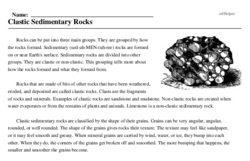Clastic Sedimentary Rocks
Rocks can be put into three main groups. They are grouped by how the rocks formed. Sedimentary (sed-uh-MEN-tuh-ree) rocks are formed on or near Earth's surface. Sedimentary rocks are divided into other groups. They are clastic or non-clastic. This grouping tells more about how the rocks formed and what they formed from.
Rocks that are made of bits of other rocks that have been weathered, eroded, and deposited are called clastic rocks. Clasts are the fragments of rocks and minerals. Examples of clastic rocks are sandstone and mudstone. Non-clastic rocks are created when water evaporates or from the remains of plants and animals. Limestone is a non-clastic sedimentary rock.
Clastic sedimentary rocks are classified by the shape of their grains. Grains can be very angular, angular, rounded, or well rounded. The shape of the grains gives rocks their texture. The texture may feel like sandpaper, or it may feel smooth and greasy. When mineral grains are carried by wind, water, or ice, they bump into each other. When they do, the corners of the grains get broken off and smoothed. The more bumping that happens, the smaller and smoother the grains become.




